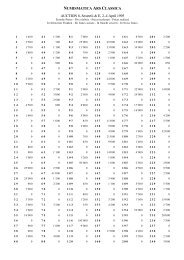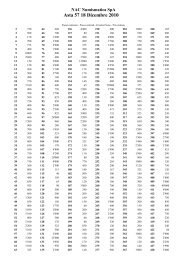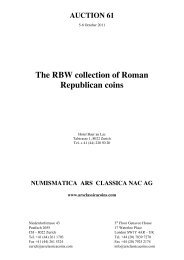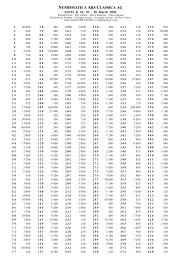The RBW collection of Roman Republican coins part II
The RBW collection of Roman Republican coins part II
The RBW collection of Roman Republican coins part II
Create successful ePaper yourself
Turn your PDF publications into a flip-book with our unique Google optimized e-Paper software.
487487 Aureus January-April 43, AV 8.09 g. C·NORBANVS / L·CESTIVS Draped bust <strong>of</strong> Sibyl r.; in r. field, PR.Rev. Cybele on throne in biga <strong>of</strong> lions l., holding patera in r. hand and resting l. hand on tympanum; in upperl. field, S·C. Babelon Cestia 3 and Norbana 5. Bahrfeldt 26 and plate IV, 22 (these dies). Sydenham 1155.Sear Imperators 196. Calicó 5 (these dies). Crawford 491/2.Rare. Reverse slightly <strong>of</strong>f-centre, otherwise extremely fine 9’000Privately purchased from H. Kreindler in April 1991.Marcus Antonius and L. Livineius Regulus488488 Aureus 42, AV 8.01 g. M·ANTONIVS – <strong>II</strong>I.VIR·R·P.C Head <strong>of</strong> M. Antonius r. Rev. L·REGVLVS –<strong>II</strong>IVIR·A·P.F Hercules seated facing on rock, holding spear and sword, with lion’s skin draped over lap; onr, shield decorated with gorgoneion. Babelon Antonia 22 e Livineia 3. C 25. Bahrfeldt 48 and plate VI, 17(these dies). Sydenham1103a. Sear Imperators 143a. Calicó 91. Crawford 494/2.Extremely rare, apparently only fifteen specimens known <strong>of</strong> which only five are inprivate hands. Struck on a very broad flan and good very fine 30’000Ex Sternberg sale 21, 1988, 324.<strong>The</strong> portrait aurei <strong>of</strong> 42 B.C. are devoted to the three members <strong>of</strong> the second triumvirate – Octavian, Antony and Lepidus.All were produced by four moneyers, Clodius, Mussidius, Varus and Regulus, and Buttrey’s proposal that the fourmoneyers struck in the same year has generally been accepted.Each moneyer struck portrait aurei for each triumvir, making it a comprehensive series. <strong>The</strong> aurei <strong>of</strong> L. Livineius Regulusare unique within the group because they are not die linked with <strong>coins</strong> <strong>of</strong> the other three moneyers. This aspect, taken withthe unusual characteristics <strong>of</strong> some <strong>of</strong> Regulus’ silver <strong>coins</strong>, allowed Buttrey to argue that Regulus was the primus, orleading member, <strong>of</strong> the college <strong>of</strong> four moneyers. If so, the <strong>coins</strong> <strong>of</strong> Regulus may have been struck first, with those <strong>of</strong>Clodius, Mussidius and Varus following in a manner that allowed them to be die linked among each other.Based upon the inscription PRAEF.VR on one <strong>of</strong> Regulus’ denarii, Buttrey suggests Regulus was serving as the praefect <strong>of</strong>the city <strong>of</strong> Rome in 42 B.C., and that his duties included control <strong>of</strong> the coinage when consuls were absent. Thus, Regulusout <strong>of</strong> necessity may have become one <strong>of</strong> the moneyers so he could perform his expanded duties as praefect.Regulus’ portrait aurei were carefully conceived, as the reverse type associated with each triumvir refers to the divineforbearers <strong>of</strong> the men: Octavian claimed descent from Venus, which is implied by Regulus’ type <strong>of</strong> Aeneas carryingAnchises; Lepidus counted Mars among his ancestors, which is alluded to by his type depicting the Vestal Virgin Aemilia;and Antony is said to have been descended form Hercules, who is shown on the aurei Regulus produced for him.As Buttrey points out, <strong>of</strong>fering descent from a divinity as a qualification for authority was not original to this series;similar overtures had been made on earlier coinage by Sulla (with Venus), Pompey (with Neptune) and Julius Caesar (withVenus). However, Regulus’ <strong>coins</strong> show a strengthening <strong>of</strong> that trend, and imply that “...the Fortune <strong>of</strong> the city was to beassured by divinity as it were made flesh.”<strong>The</strong> portrait die <strong>of</strong> this specimen was paired only with one reverse die, assuring us that it did not have a <strong>part</strong>icularly longlife. Stylistically it is perhaps the finest <strong>of</strong> all the Antony portrait dies employed by these moneyers. <strong>The</strong> inscription <strong>II</strong><strong>II</strong>VIR A P F is instructive, if not entirely clear. It almost certainly abbreviates quatuorviri argento publico feriundo orquattuorvir auro publico feriundo, with the latter representing the first time gold was included as <strong>part</strong> <strong>of</strong> the regular issues– something <strong>of</strong> a landmark in the development <strong>of</strong> <strong>Roman</strong> coinage.110
















